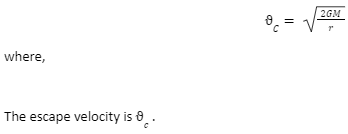Although the phrase “escape velocity” is commonly used, it is more appropriately described as a speed rather than a velocity because it is directionless; the escape speed increases with the primary body’s mass and decreases with distance from the primary body. The object’s escape speed is thus determined by how far it has already travelled, and its computation at a particular distance takes into consideration the fact that it will slow down as it travels owing to the enormous body’s gravity, but it will never come to a complete stop .Because it continues to contribute kinetic energy from its engines, a rocket continually driven by its exhaust can escape without ever achieving escape speed. It is capable of escaping at any pace.
Theory
Why doesn’t a ball go through the atmosphere and into space when you hurl it up in the air? The reason for this is that gravity pulls it back down. So, how does a rocket reach the farthest reaches of the universe? Because it is travelling at such a great speed, it can fly into space. This speed is referred to as escape velocity. The escape velocity of celestial bodies such as planets and their natural satellites (for us, the moon) is the lowest velocity that an item must accomplish in order to escape the celestial body’s gravitational zone of influence (pull or force or attraction). The total of the system’s gravitational potential energy and kinetic energy will be 0 at this velocity.
What is the definition of Escape Velocity?
Escape velocity is the speed where an object can break free from the gravitational pull of the planet or moon and leave without developing propulsion.
Equation of Escape Velocity
The escape velocity equation is calculated by combining the kinetic energy of an item with mass m and a velocity of v with the gravitational potential of the same object.

The gravitational constant is referred to as G.
The mass of the heavenly object whose gravitational force must be overcome is denoted by M.
The distance between the object and the centre of mass of the body to be escaped is given by r.
Because larger planets (or celestial bodies) have a larger mass than smaller planets with a lower mass, escape velocities for larger planets (or celestial bodies) are obviously greater (having less gravity in comparison).
Escape Velocity of Earth
For earth, the acceleration due to gravity, g = 9.8 m/s2
The radius of the earth, R = 6.4 × 106 m
The escape velocity of the earth, ve = √2 × 9.8 × 6.4 × 106
Therefore, ve = 11.2 × 103 m/s = 11.2 km/s
The escape velocity on Earth is approximately 40,270 kmph, or 11,186 m/s.
For example, when a spacecraft is launched into outer space, the speed it receives must be greater than the speed of escape so that the rocket does not return to the earth. And guess what, the speed of escape is different from the poles of the earth compared to that from the equator because the radius is slightly higher than the equator.
It is said that it is impossible to escape the black hole because the magnetic field inside the equator is so large that the calculated speed is greater than the speed of light!
Escape Speed for Different Items
The following is escape for the different celestial bodies:
Escape Body Speed in km / s
Sun – 618 km / s
Moon – 2.38 km / s
Earth – 11.2 km / s
Jupiter – 59.5 km / s
Ceres – 0.64 km / s
Conclusion
When it comes to planet Earth, the speed of escape is the first speed needed to start the shell at the top, in this case it should be a top speed of 11 km / s to end outside the earth’s atmosphere, so we can say that the speed to release gravity. When it comes to planet Earth, the speed of escape is the first speed needed to start the shell at the top, in this case it should be a top speed of 11 km / s to end outside the earth’s atmosphere, so we can say that the speed to release gravity.
 Profile
Profile Settings
Settings Refer your friends
Refer your friends Sign out
Sign out






